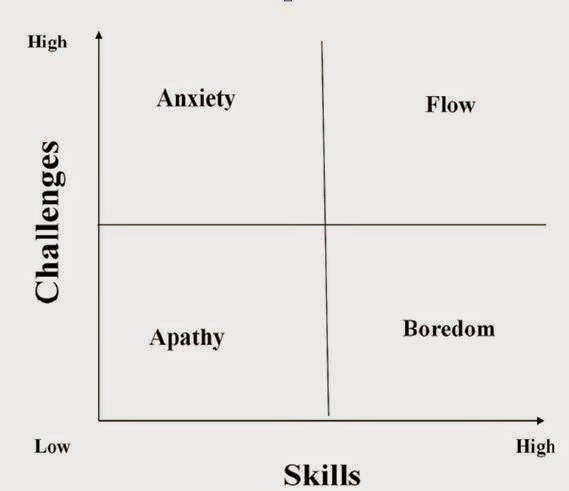http://dl.acm.org/citation.cfm?id=2639189
Since we are evaluating our game it is a good idea to look at some other papers and how they handled their evaluations. The given website provides good articles were some kind of innovative new technology is tested and evaluated. DinoTopHat chose these 3 papers: "Wayfinding for older people with memory decline", "Profiling user experience in digital games using the flow model" and "Lean UX - The Next Generation of User-Centered Agile Development?". A short powerpoint was made for each one and you can find a link to them in each section.
Wayfinding for older people with memory problems:
link to slides
This paper is about a research team that looks for the best way in aiding older people that have some kind of memory problem in finding their way home. For this they evaluated 2 apps (Home Compass and NavMem explorer) on 13 people from which 8 already had a stroke in the past. The home compass was a simple app that only provides the direction and distance to your home location, how you get there is up to you. The NavMem explorer is a combination of the home compass and turn-by-turn (directions are given at every possible moment) guiding. You need to pass a list of landmarks to get to your home location.
Most important results and what to remember:
In the slides you can see the different screens from both applications. The ease of use of the home compass was pointed out as a good thing by half of the test users. The displayed text in the NavMem explorer was unreadable by some participants and the displayed text when you arrived was not clear for 3 participants. All in all we'll remember to pursue an easy to use application with fast learnability. The amount of test participants was in this experiment too low since so many different preferences and opinions came to light and all the different circumstances played a part in that. It is important to make the right conclusions depending on the circumstances the test participants are in. When conclusions can not be made with a small user group it is obviously necessary to do more tests/evaluations.
Profiling user experience in digital games using the flow model:
link to slides
This paper is about how the flow model can be used to analys user experience in digital games. Flow is a psychological term used to describe the mental state of a person who is fully immersed in an interesting activity. The flow model can be used to analyse this flow by examining the balance between the challenges the activity poses and the skills of the person participating in the activity. That balance can be divided in 4 channels: Apathy, Anxiety, Boredom and Flow (see image below).
 |
| 4 channel flow model |
Most important results and what to remember:
The authors concluded from their results that the names of the Apathy, Anxiety and Boredom channels, were not the most accurate names for these channels in the context of gaming. In the general model those channels go hand in hand with actual negative emotions (eg.: people in the Boredom channel of other experiments with the flow model were actually bored.), whereas the data from the gamers generally does not point towards these negative emotions. That's why the authors of the paper propose to rename Apathy, Anxiety and Boredom into respectively Impassiveness, Overwhelm and Relaxation (in the context of gaming only). Something we can remember from this paper is that using the flow model to analyse the user experience of our casual game can give us insight in how our players experience our game, so we can evolve it in the right direction.
Lean UX - The Next Generation of User-Centered Agile Development?:
link to slides (pdf)
The authors provide a brief overview of the philosophy of Lean-UX, a next generation framework for developing software in a user-centered fashion. They further give an account of how they implemented several aspects in the company the work.
Lean-UX is build around the design thinking movement, the lean start up method and agile programming practices. The process is based on sprints, with each sprint attempting to deliver a minimum viable product (MVP). These MVPs are evaluated at the end of each development week with user testing. It is important that all stakeholders are incorporated in the teams working in such sprints.
The authors classified the changes needed to incorporate this model into their way of working into two subsets, team and organisational. They found that within their own teams, the only thing that really required their attention was the integration of more skills within their teams, teaching their UX-developers UX-researching techniques for example.
On the organisational side they found more hurdles, related IT outsourcing and decision making.
Most important results and what to remember:
The concepts of Lean-UX provide a more formal framework for the way we have been developing our casual game. Especially the principles of the lean start-up are interesting to apply more thoroughly. These principles tell us to see a product as a hypothesis for the solution of a problem the consumer might have. In our case the problem would be to have no good way to pass time. Our solution would be our casual game. Defining this hypothesis more clearly would give us a better direction of what we want. Furthermore defining a product as a hypothesis forces us to define when our evaluation rejects or accepts our hypothesis, giving room to a clearer conclusion.
In corporating ideas of Lean-UX should help us create, evaluate and ultimately finish our game faster with less wasted resources.
We will try to use our received knowledge from these papers in our own evaluations to systematically improve our end product!
Geen opmerkingen:
Een reactie posten